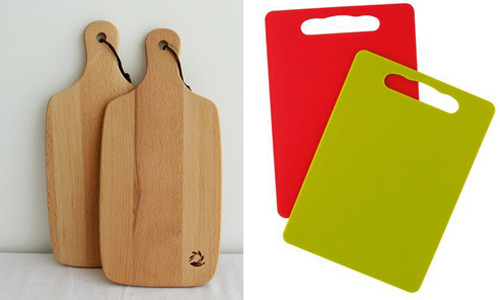Wooden cutting boards are proven cleaner than plastic cutting boards
With a wooden cutting board, the bacteria will be sucked down under the grooves on the cutting surface, where they will no longer reproduce and will even die.
The biggest utility of plastic cutting board is mainly in its smooth surface . People can pour boiling water or scrub the plastic cutting board without worrying about cutting boards. But is that the reason why plastic boards are actually better than wooden boards?
Professor Dean O. Cliver, a food safety expert at the University of California (USA) and a group of students cultured salmonella bacteria on a plastic cutting board and used wooden cutting boards and then used dishwashing rugs to make Clean cutting boards with soap and hot water.
With a wooden cutting board, the bacteria will be sucked down under the grooves on the cutting surface, where they will no longer reproduce and will even die. Even old wooden grooves with deep grooves also show that the level of microbial survival is less like new cutting boards.
"You might think the bacteria under the grooves will get back into the food when we use the chopping knife , " Cliver told Rodalesorganiclife recently. However, his research shows that bacteria never reappear on the cutting surface, even when food is chopped multiple times with a sharp blade.

The wooden cutting board will suck the bacteria down, while the plastic cutting board will not do this.So bacteria are still on the surface of the plastic cutting board, causing unsafety.
Meanwhile, plastic chopping boards that have been cleaned and disinfected up to several times still remain bacteria."With plastic cutting boards, even if they have been washed under hot water, the bacteria in the trench are still alive. Dishwashers also do not remove the problem because the bacteria do not die but settle and stick back on the bowl. In dishwashers, even when using disinfecting water (such as chlorine bleach), there are still bacteria left in the cutting groove , "Cliver said.
A similar study conducted by the Institute of Technology and Management also showed that unless disinfectant is soaked all night, the extremely easy-to-stick plastic cutting board adheres to difficult to remove scum from foods. These types of scum are the ideal environment for bacteria and fungi to proliferate.
Applying the research of Professor Cliver, both the US Department of Agriculture (USDA) and the US Food and Drug Administration (FDA) have all advised people to use cutting boards from maple (also called maple wood, type of wood). used for cutting boards in the US) or other hardwoods. However, keep in mind that you will not benefit from using a wooden cutting board if you do not clean the cutting board before you use it. Cliver advises: "Don't let food residues get on the cutting board surface. Even when using it, you need to clean it."
Professor Cliver also did an experiment and found that the microwave oven could effectively kill bacteria , including those deep down the surface. So, the expert advises, after washing the cutting board in the usual way, put the cutting board in the microwave, leave it for five minutes, do so about twice a week. Only apply this procedure with a wooden cutting board, do not allow the plastic cutting board because it is not heat resistant. Also do not put a wooden board with metal wrapped in the microwave.
- The danger of 'death' stalks from using plastic cutting boards
- It turns out we all wash the cutting board the wrong way
- You will immediately remove the cleaning board with dishwashing liquid after knowing this
- Risk of poisoning from plastic chopsticks and wooden chopsticks
- Shouting sharks 'hunting' plastic waste
- New technology turns waste plastic powder of electronic circuit boards into building bricks
- Internationally recognized topical toxins of cancer-causing toxins, many still use them
- Sharp is coming out of the vacuum cleaner market to say
- History of the vacuum cleaner
- Beautiful creative paper cut art like fairy
- Vacuum vacuum cleaner with 360 degree view
- Russian scientists introduced micro-vacuum cleaner to help clean the environment from harmful particles
 Green tea cleans teeth better than mouthwash?
Green tea cleans teeth better than mouthwash? Death kiss: This is why you should not let anyone kiss your baby's lips
Death kiss: This is why you should not let anyone kiss your baby's lips What is salmonellosis?
What is salmonellosis? Caution should be exercised when using aloe vera through eating and drinking
Caution should be exercised when using aloe vera through eating and drinking